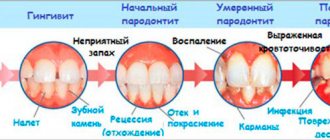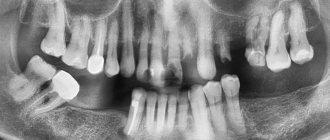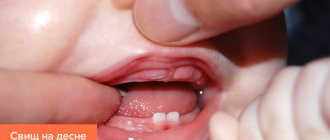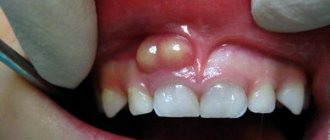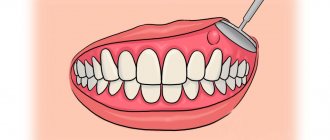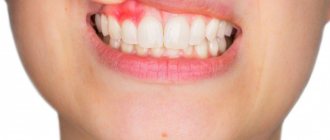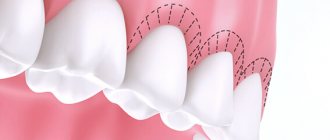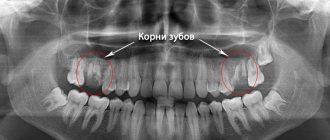Flap surgery is an innovative method of treating periodontitis through surgery. This method of eliminating damaged periodontal tissue is considered the most effective, which allows you to stop the pathological process for a long period of time and keep the dentition intact.
The name of the procedure is due to the formation of a flap of gum tissue with vertical incisions on both sides above the projection of damaged teeth, which, after all manipulations, is sutured back, thereby ensuring maximum fit and aesthetics. The operation gives the doctor maximum access to periodontal tissues and roots, which must be cleaned of pathological plaque, tartar and atrophied tissues due to a long-term inflammatory process.
What is periodontitis?
Periodontitis is a chronic inflammation of the soft and hard tissues of the periodontium, which is practically asymptomatic in the initial stages of development, but poses a real threat of premature tooth loss. The etiology of the disease is determined by insufficient oral care, impaired circulation of the gums due to smoking and chronic deficiency of vitamins and minerals.
Obvious signs of the disease appear already at advanced stages of the pathological process and are expressed by the following symptoms:
- bleeding gums, which appears gradually, that is, first with strong mechanical impact, and then with slight pressure from the toothbrush;
- unpleasant and persistent odor from the mouth, which is difficult to hide with anything;
- teeth become very sensitive to any irritating factors, for example, cold and hot drinks, sour or salty foods;
- tooth mobility is felt, worsening over time;
- chewing food develops into a real problem;
- the gums become uneven, with elements of white atrophy;
- swelling of the gums periodically increases;
- a metallic taste appears in the mouth;
- quality of life deteriorates significantly.
If these symptoms are present, doctors diagnose stage 3 or 4 periodontitis, with the presence of deep periodontal pockets and significant damage to the tissue of the alveolar process. Advanced stages of inflammation of the root tissues of the tooth are a direct indication for surgical treatment using flap surgery.
To prevent the development of advanced stages of periodontitis, it is necessary to undergo regular preventive examinations and pay due attention to oral hygiene using high-quality toothpaste and an antiseptic rinse. Also important is the technique of brushing your teeth, the duration of this manipulation and the frequency, at least twice a day. At the first pathological signs in the form of streaks of blood while brushing your teeth, you should definitely consult a dentist.
In our clinic, your operation will be performed by highly qualified doctors using the latest equipment and medications, which guarantees the maximum effect of treatment.
The name of the procedure is due to the formation of a flap of gum tissue with vertical incisions on both sides above the projection of damaged teeth, which, after all manipulations, is sutured back, thereby ensuring maximum fit and aesthetics. The operation gives the doctor maximum access to periodontal tissues and roots, which must be cleaned of pathological plaque, tartar and atrophied tissues due to a long-term inflammatory process.
What is periodontitis?
Periodontitis is a chronic inflammation of the soft and hard tissues of the periodontium, which is practically asymptomatic in the initial stages of development, but poses a real threat of premature tooth loss. The etiology of the disease is determined by insufficient oral care, impaired circulation of the gums due to smoking and chronic deficiency of vitamins and minerals.
Obvious signs of the disease appear already at advanced stages of the pathological process and are expressed by the following symptoms:
- bleeding gums, which appears gradually, that is, first with strong mechanical impact, and then with slight pressure from the toothbrush;
- unpleasant and persistent odor from the mouth, which is difficult to hide with anything;
- teeth become very sensitive to any irritating factors, for example, cold and hot drinks, sour or salty foods;
- tooth mobility is felt, worsening over time;
- chewing food develops into a real problem;
- the gums become uneven, with elements of white atrophy;
- swelling of the gums periodically increases;
- a metallic taste appears in the mouth;
- quality of life deteriorates significantly.
If these symptoms are present, doctors diagnose stage 3 or 4 periodontitis, with the presence of deep periodontal pockets and significant damage to the tissue of the alveolar process. Advanced stages of inflammation of the root tissues of the tooth are a direct indication for surgical treatment using flap surgery.
To prevent the development of advanced stages of periodontitis, it is necessary to undergo regular preventive examinations and pay due attention to oral hygiene using high-quality toothpaste and an antiseptic rinse. Also important is the technique of brushing your teeth, the duration of this manipulation and the frequency, at least twice a day. At the first pathological signs in the form of streaks of blood while brushing your teeth, you should definitely consult a dentist.
Indications for flap surgery
Surgical intervention aimed at stabilizing periodontitis is not a cheap method, but its effectiveness guarantees long-term remission of the pathology, which will save financial resources that would have to be spent on endless trips to the dentist if the patient, for example, turned to a doctor who practices outdated non-invasive treatment methods.
Manipulations of the last century can become expedient only in the treatment of initial forms of inflammation of periodontal tissue. For flap surgery, doctors determine the following indications:
- progressive periodontitis in advanced forms of clinical course (stages 3 and 4);
- the presence of gingival pockets with a depth of more than 4-5 millimeters;
- presence of bone tissue destruction;
- pathological changes in gum tissue caused by thinning, atrophy and the appearance of fibrous structures;
- tooth root exposure;
- severe mobility of the teeth, which poses a problem when chewing food;
- formation of large gaps between teeth.
With the help of an incision in the gums, it becomes possible to stabilize the situation, reverse these manifestations and preserve the vitality and functionality of the teeth for many years.
Contraindications
Like any surgical intervention on the human body, patch surgery also has a number of contraindications that should be taken into account. Thus, treatment of periodontitis using flap surgery may be impossible for the following reasons:
- immunodeficiency conditions (AIDS, hepatitis B and C);
- extreme degree of destruction of bone tissue, which accounts for more than half the volume of the alveolar processes;
- a pronounced tissue defect at the junction of the tooth root and the crown;
- advanced degrees of cardiovascular pathologies;
- congenital heart defects;
- the presence of artificial joints;
- diabetes mellitus in the stage of decompensation;
- acute and chronic blood diseases;
- cirrhosis of the liver;
- infectious processes in the oral cavity;
- a burdened allergy history, which calls into question the possibility of using anesthesia during surgery, which is impossible to do without.
If there are contraindications, periodontitis is treated using non-invasive methods, which does not guarantee a stable effect and long-term remission. The pathological changes in the body themselves, characteristic of the pathologies listed above, can provoke an exacerbation of periodontal inflammation.
Preparatory stage
Surgical manipulations on the gums require special preparation to avoid complications during surgery and in the postoperative period. After the patient has received a referral for flap surgery, he will undergo thorough preparation, which consists of the following aspects:
- clinical examinations (general blood count, urine test and glycemic indicators);
- determination or confirmation of blood type;
- elimination of all foci of inflammation in the oral cavity;
- ridding the visible part of the teeth of plaque and tartar;
- performing splinting if there is severe tooth mobility;
- general anti-inflammatory therapy with the use of antibacterial drugs is used to prevent possible complications of an infectious nature;
- Patients with a phobia may need to consult a psychologist before the upcoming treatment process.
The preparatory stage before flap surgery usually lasts 5-7 days.
Progress of the operation
The course of the operation is determined by the following sequential actions of the dental surgeon:
- treatment of the oral cavity with special antiseptic solutions;
- providing local anesthesia through injections around the surgical area;
- making two vertical incisions from the fold to the edge of the gum and a horizontal incision along the lower edge;
- a so-called periosteal flap is formed from tissues;
- instrumental provision of access to affected periodontal tissues;
- removal of pathological areas from the alveolar bone (cleaning the periodontal pocket);
- removal of tartar and grinding of tooth roots;
- after the cleaning stage, the surface is again carefully treated with an antiseptic;
- if there is a clear deficiency of bone tissue, the doctor fills it with transplantation materials, which usually take root well and contribute to the formation of one’s own bone;
- after completion of all planned manipulations, the flap is returned to its original place, where it is sutured in the spaces between the dental units;
- The doctor applies an antiseptic napkin to the postoperative surface and covers it with a periodontal bandage.
After 4-5 days, the doctor removes the stitches or they dissolve on their own, which depends on the suture material used. The doctor gives mandatory recommendations for oral care, which will allow you to maintain the results for many years.
Recommendations in the postoperative period
In order to preserve and consolidate the result obtained after flap surgery, the patient must strictly follow all the doctor’s recommendations from the end of the procedure and for a long period of time.
The dentist's instructions will be as follows:
- pressing the tampon applied after surgery with teeth for 3-4 hours;
- on the first day, cold should be applied to the projection area of the operated gum, from the outside, to reduce tissue swelling;
- in case of severe pain, you can take analgesic drugs, taking into account the recommended dose and frequency of use;
- sometimes the doctor may prescribe the administration of narcotic painkillers;
- to prevent the development of postoperative complications, the doctor prescribes a course of antibacterial drugs for 5-7 days;
- in the first 7-8 hours after surgery, you should not brush your teeth or rinse your mouth;
- after 8 hours, the doctor recommends regular rinsing of teeth with salted water, antiseptic solutions or decoctions of anti-inflammatory medicinal plants every 4 hours;
- from the beginning of the 2-3 days of the postoperative period, you can begin to carefully brush your teeth, but only with a soft brush using a desensitizing paste;
- food should only be soft and not irritate the postoperative wound (exclude salt, pepper, acidic foods);
- active physical activity should be limited for several weeks;
- visiting saunas, swimming pools and gyms is prohibited;
- Smoking after surgery can cause bleeding, so the doctor recommends abstinence.
Such easy-to-follow recommendations will help you avoid various complications and consolidate the results obtained.
Possible complications during and after gum surgery
Typically, surgical intervention for the treatment of periodontitis is well tolerated by patients, which is ensured by modern equipment and fully equipped dental offices. However, the possibility of complications is always present, since the reaction of the human body to the action of any factor can be unpredictable. The following facts about possible complications are described from the practice of leading dentists:
- the development of bleeding during and after surgery, which is successfully controlled by appropriate measures;
- the risk of postoperative inflammation is always present, but in practice it is no more than 5-10%;
- rejection of bone material, which is introduced to compensate for the deficit in the volume of the alveolar process of the tooth, which is considered an indication for repeated surgery with a change of prosthetic material;
- allergic reaction to drugs used for anesthesia;
- severe swelling of tissues in the area of manipulation;
- severe pain that lasts 5-7 days;
- discomfort during brushing your teeth, when eating and during normal conversation lasts no more than 2-3 weeks and goes away without a trace.
The likelihood of complications developing is quite low and often depends on the thoroughness of the preparatory stage and compliance with postoperative recommendations.
Indications for flap surgery
Surgical intervention aimed at stabilizing periodontitis is not a cheap method, but its effectiveness guarantees long-term remission of the pathology, which will save financial resources that would have to be spent on endless trips to the dentist if the patient, for example, turned to a doctor who practices outdated non-invasive treatment methods.
Manipulations of the last century can become expedient only in the treatment of initial forms of inflammation of periodontal tissue. For flap surgery, doctors determine the following indications:
- progressive periodontitis in advanced forms of clinical course (stages 3 and 4);
- the presence of gingival pockets with a depth of more than 4-5 millimeters;
- presence of bone tissue destruction;
- pathological changes in gum tissue caused by thinning, atrophy and the appearance of fibrous structures;
- tooth root exposure;
- severe mobility of the teeth, which poses a problem when chewing food;
- formation of large gaps between teeth.
With the help of an incision in the gums, it becomes possible to stabilize the situation, reverse these manifestations and preserve the vitality and functionality of the teeth for many years.
Gum plastic surgery during implantation
Gumplasty is performed when the root is exposed, after tooth implantation. Often the need for this operation arises when an implant is installed in place of a long-missing tooth. In this case, the correct gum line is not only aesthetic. It protects the implant from infection and the development of peri-implantitis, which without proper treatment can lead to the loss of the entire structure. In addition, it allows you to prevent further exposure of the roots, reduce tooth hypersensitivity, reduce the likelihood of root destruction and, of course, improve the aesthetics of your smile.
Contraindications
Like any surgical intervention on the human body, patch surgery also has a number of contraindications that should be taken into account. Thus, treatment of periodontitis using flap surgery may be impossible for the following reasons:
- immunodeficiency conditions (AIDS, hepatitis B and C);
- extreme degree of destruction of bone tissue, which accounts for more than half the volume of the alveolar processes;
- a pronounced tissue defect at the junction of the tooth root and the crown;
- advanced degrees of cardiovascular pathologies;
- congenital heart defects;
- the presence of artificial joints;
- diabetes mellitus in the stage of decompensation;
- acute and chronic blood diseases;
- cirrhosis of the liver;
- infectious processes in the oral cavity;
- a burdened allergy history, which calls into question the possibility of using anesthesia during surgery, which is impossible to do without.
If there are contraindications, periodontitis is treated using non-invasive methods, which does not guarantee a stable effect and long-term remission. The pathological changes in the body themselves, characteristic of the pathologies listed above, can provoke an exacerbation of periodontal inflammation.
general information
The result of gum recession is that the bottom of the tooth is exposed. As a result, not only an aesthetic problem arises, but also the possibility of developing serious pathologies, such as wedge-shaped defects. Increased sensitivity of enamel, caries, etc.
This disease is quite rarely diagnosed at a young age (no more than 10% of patients).
Its manifestation is most often observed in middle and old age. Important! Gum recession belongs to the group of diseases that can have a negative impact on the facial aesthetics and psycho-emotional state of the patient. When you smile, the exposed roots of the teeth are clearly visible, which has an overwhelming effect on self-esteem, causing difficulties in communication and difficulty in social adaptation. And the more pronounced this pathology is, the stronger the person’s psychological uncertainty will be.
Preparatory stage
Surgical manipulations on the gums require special preparation to avoid complications during surgery and in the postoperative period. After the patient has received a referral for flap surgery, he will undergo thorough preparation, which consists of the following aspects:
- clinical examinations (general blood count, urine test and glycemic indicators);
- determination or confirmation of blood type;
- elimination of all foci of inflammation in the oral cavity;
- ridding the visible part of the teeth of plaque and tartar;
- performing splinting if there is severe tooth mobility;
- general anti-inflammatory therapy with the use of antibacterial drugs is used to prevent possible complications of an infectious nature;
- Patients with a phobia may need to consult a psychologist before the upcoming treatment process.
The preparatory stage before flap surgery usually lasts 5-7 days.
Methods for treating periodontal disease
The main treatment for periodontal disease is regular hygiene, diagnosis of periodontal condition, dietary correction, and bite (occlusion) correction.
Effective are effects that improve blood supply to gum tissue and improve metabolism in them:
- regular gum massage;
- electrophoresis;
- exposure to ultrasound;
- ultraviolet irradiation and so on.
In a number of sanatoriums both in Russia and abroad, especially in those where therapeutic mud or water sources are used, you can find special programs aimed at improving the condition of the gums and the entire oral cavity as a whole.
Progress of the operation
The flap surgery procedure is performed in a specially equipped dental office.
The course of the operation is determined by the following sequential actions of the dental surgeon:
- treatment of the oral cavity with special antiseptic solutions;
- providing local anesthesia through injections around the surgical area;
- making two vertical incisions from the fold to the edge of the gum and a horizontal incision along the lower edge;
- a so-called periosteal flap is formed from tissues;
- instrumental provision of access to affected periodontal tissues;
- removal of pathological areas from the alveolar bone (cleaning the periodontal pocket);
- removal of tartar and grinding of tooth roots;
- after the cleaning stage, the surface is again carefully treated with an antiseptic;
- if there is a clear deficiency of bone tissue, the doctor fills it with transplantation materials, which usually take root well and contribute to the formation of one’s own bone;
- after completion of all planned manipulations, the flap is returned to its original place, where it is sutured in the spaces between the dental units;
- The doctor applies an antiseptic napkin to the postoperative surface and covers it with a periodontal bandage.
After 4-5 days, the doctor removes the stitches or they dissolve on their own, which depends on the suture material used. The doctor gives mandatory recommendations for oral care, which will allow you to maintain the results for many years.
Preparation
The following preparations may be required before surgery is performed:
- in-office removal of plaque and tartar;
- six months before surgery, closed curettage is performed (according to indications);
- taking anti-inflammatory drugs;
- temporary immobilization, splinting;
- if necessary, a course of antibiotics is prescribed for two to three days.
To determine the treatment regimen, the doctor prescribes an examination:
- taking anamnesis, assessing the condition of tissues;
- performing laboratory tests;
- instrumental examinations.
Result of flap surgery
Experts believe that the result of flap surgery is the stabilization of periodontitis until complete remission, which is confirmed by the following facts:
- complete elimination of periodontal pockets;
- replenishment of the volume of dental bone tissue;
- elimination of tooth mobility;
- effective correction of the gum edge, which due to prolonged inflammation has undergone severe hyperplasia and does not fit tightly to the tooth;
- elimination of overhanging gums.
The surgical treatment of periodontitis allows you to restore the functionality and aesthetics of the dentition as much as possible.
[slide-anything id=”3470"]
Open curettage of periodontal pockets
This type of operation does not have the disadvantages of the previous method. A good overview of the problem area allows the doctor to remove all granulation tissue and thereby prevent further progression of the disease. Open curettage is performed under local anesthesia and takes place in several stages:
- The surgeon makes an incision in the gum in the projection of the neck of the tooth.
- A certain area of the mucous membrane peels off.
- Granulations and deposits in periodontal pockets are eliminated.
- If necessary, plastic surgery of bone defects is performed.
- The flap is sutured, the surgical field is treated and protected with an aseptic dressing.
Due to the high traumatic nature of soft tissues, a limited area of gum can be treated in one operation, usually up to 8 teeth. After the wound has healed, repeated interventions are performed.
Recommendations of the periodontist in the postoperative period
In order to preserve and consolidate the result obtained after flap surgery, the patient must strictly follow all the doctor’s recommendations from the end of the procedure and for a long period of time.
The dentist's instructions will be as follows:
- pressing the tampon applied after surgery with teeth for 3-4 hours;
- on the first day, cold should be applied to the projection area of the operated gum, from the outside, to reduce tissue swelling;
- in case of severe pain, you can take analgesic drugs, taking into account the recommended dose and frequency of use;
- sometimes the doctor may prescribe the administration of narcotic painkillers;
- to prevent the development of postoperative complications, the doctor prescribes a course of antibacterial drugs for 5-7 days;
- in the first 7-8 hours after surgery, you should not brush your teeth or rinse your mouth;
- after 8 hours, the doctor recommends regular rinsing of teeth with salted water, antiseptic solutions or decoctions of anti-inflammatory medicinal plants every 4 hours;
- from the beginning of the 2-3 days of the postoperative period, you can begin to carefully brush your teeth, but only with a soft brush using a desensitizing paste;
- food should only be soft and not irritate the postoperative wound (exclude salt, pepper, acidic foods);
- active physical activity should be limited for several weeks;
- visiting saunas, swimming pools and gyms is prohibited;
- Smoking after surgery can cause bleeding, so the doctor recommends abstinence.
Such easy-to-follow recommendations will help you avoid various complications and consolidate the results obtained.
Possible complications during and after gum surgery
Typically, surgical intervention for the treatment of periodontitis is well tolerated by patients, which is ensured by modern equipment and fully equipped dental offices. However, the possibility of complications is always present, since the reaction of the human body to the action of any factor can be unpredictable. The following facts about possible complications are described from the practice of leading dentists:
- the development of bleeding during and after surgery, which is successfully controlled by appropriate measures;
- the risk of postoperative inflammation is always present, but in practice it is no more than 5-10%;
- rejection of bone material, which is introduced to compensate for the deficit in the volume of the alveolar process of the tooth, which is considered an indication for repeated surgery with a change of prosthetic material;
- allergic reaction to drugs used for anesthesia;
- severe swelling of tissues in the area of manipulation;
- severe pain that lasts 5-7 days;
- discomfort during brushing your teeth, when eating and during normal conversation lasts no more than 2-3 weeks and goes away without a trace.
The likelihood of complications developing is quite low and often depends on the thoroughness of the preparatory stage and compliance with postoperative recommendations.
